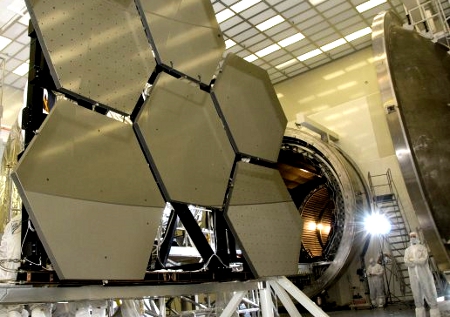Feature: Out of This World
Last year, Brittany Hinyard’s eighth graders became astronomers.
Students built models of the solar system, used software to make planets gravitate toward or apart from each other, and sought out information on satellites. They observed and interpreted data, and made educated guesses on what they thought would happen when the planets moved from their normal orbits around the sun. Would Saturn and Jupiter collide, for example, if their trajectories were closer?
“I wanted it to be fun and not lecture style,” says Hinyard, a science teacher at Baker Middle School near Baton Rouge, La. “Not only do they have fun, but they are learning important scientific concepts.” Studying Newton’s Laws of Motion, groups had to come up with ways to demonstrate these laws using pennies, balloons, string, ruler, tape, and a triple balance beam scale. Turning to the stars, the students learned about telescopes—how they work and what materials go into their giant polished mirrors.
Teaching this way, emphasizing inquiry, multiple science disciplines, and team learning, requires an extra commitment. Hinyard develops the lessons herself, and dips into her own pocket for the needed materials. Or, she might arrange a field trip, such as a class tour of an ExxonMobil plant that demonstrated how crude oil is converted to gasoline.
For a chemistry lesson, students had to pick an element from the Periodic Table and were required to make brochures so they could sell their element. The classroom was set up like a market during the activity. Teachers and other students came around with fake money to purchase a few elements. The more reliable and creative the brochure, the more money a student could earn. Each student had to earn five dollars to get a good grade. Each element was worth 50 cents.
Typically, Hinyard lets the level of students’ interest in a topic guide how much time is devoted to it. Astronomy absorbed them for a full month. Other subjects might last just an hour.

Her imaginative and no-nonsense approach (“I don’t allow my students to get away with a lot of foolishness”) has brought rewards to Hinyard, both in prestige and professional satisfaction. She has been named the 2010 Teacher of the Year by the City of Baker School System, and been recognized as the Southern University Robert Noyce Scholar for the last two years. Sponsored by the National Science Foundation, Noyce scholarships go to science and math teachers in high-needs school districts.
Hinyard has seen her students gain on test scores, but seeks additional, intangible benefits. “My students are my future,” she says. “They must be trained correctly and with a sense of ownership—plus fun—so when they get older and must make a decision to choose science or English, they might think back to all they learned in Mrs. Hinyard’s science class and be persuaded to choose science.”
Filed under: Special Features
Tags: Astronomy, Science Teachers, Teachers








